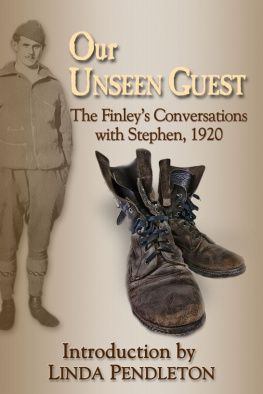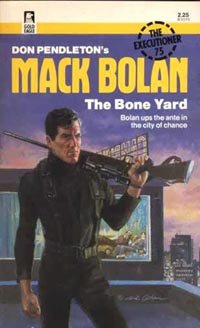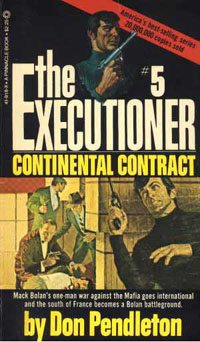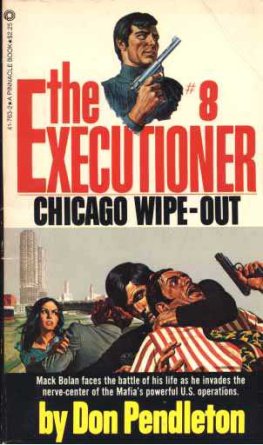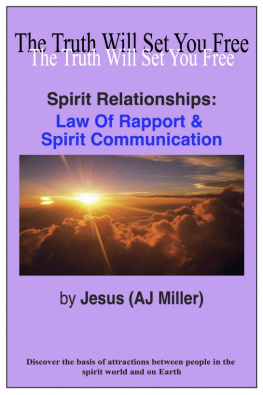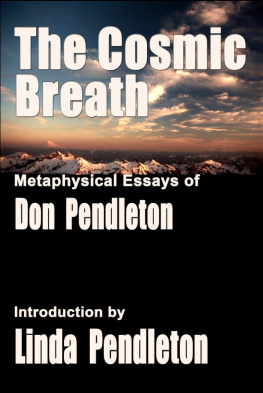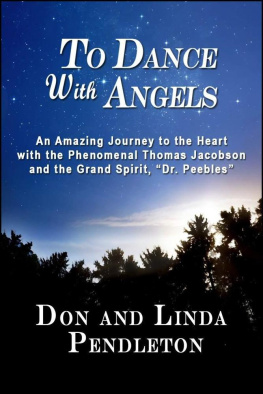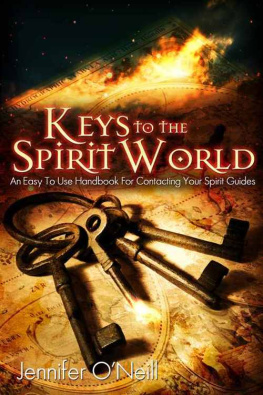OUR UNSEEN GUEST,
The Finleys Conversations withStephen, 1920
Introduction by LindaPendleton
Emmet and Ruth Finleypublished Our Unseen Guest under the names Darby and Joan in 1920, PublicDomain.
Introduction Copyright 2011 by LindaPendleton.
All Rights Reserved.
Cover Design by Judy Bullard
For Smashwords by Linda Pendleton
Smashwords Edition, License Notes:
This edition is licensed for your personalenjoyment only. This ebook may not be re-sold or given away toother people. If you would like to share this book with anotherperson, please purchase an additional copy for each person. If youare reading this book and did not purchase it, or it was notpurchased for your use only, then please return to Smashwords.comand purchase your own copy. Thank you for respecting the hard workand rights of the author.
INTRODUCTION
Since the 1700s, Darby and Joan have beenconsidered to be a happily married, middle-aged couple living aquiet and uneventful life. Poems have been written, especiallyduring Victorian times, referring to this imaginary couple.
But the Darby and Joan,authors of Our UnseenGuest , published in 1920, were hardlyliving an uneventful life. And it would be several years laterbefore their true identity would be revealed.
The couple were professionals and haddecided not to reveal their identities due to the subject matter oftheir book: conversations with an American soldier who died inWorld War I in France. They believed they could not risk theirprofessional careers with the controversy their book was sure tobring. You see, Joan became a medium for this dead soldier. Overtime he gave them information on life, and life after death and thecontinuation of consciousness.
So who was this mystery couple who wereinvestigating what some consider to be the paranormal, while manyothers would consider their experiences to be extraordinary andawe-inspiring but within the norm of the human experience?
And who was this dead man who became knownas Stephen?
Within the book, Our Unseen Guest , youwill come to know who they were, and also you may learn more aboutlife, life after death, and how consciousness lives on after thedeath of the physical body.
Joan was actually RuthEbright Finley. Ruth was born in 1884 in Akron, Ohio, daughter Dr.L.S. Ebright and his wife, Julia Ann Bissell. Her father was aphysician and also at one time a postmaster of Akron. She studiedat Oberlin in 1902, and the next term at Buchtel College but nevercompleted her college degree.
After college she began anewspaper reporting career at the Akron Beacon Journal , and soon gained a name forherself. She moved on to the ClevelandPress and became know there for writingstories about working conditions of women. Sshe was also creditedwith helping to get a bill passed to benefit workingwomen.
It was at the Cleveland Press that shemet Emmet Finley, an editor there. They were married soonafter.
Emmet Finley was born in Salem, Ohio in1881, son of Richard and Mary Barr Finley. In 1903, he received adegree from Adelbert College of Western Reserve and a law degreethere in 1906. He was admitted to the Ohio bar in 1907.
He began a career as a newspaper reporter,editor, and held management positions in various newspaper printingand supply companies and organizations. He died in Dobbs Ferry, NewYork December 13, 1950.
Ruth Finleys career wasvaried. She worked as a reporter, editor of magazines andperiodicals, and was an historian, author and feminist. She wrotethe book, Old Patchwork Quilts and theWomen Who Made Them . She designed a quilt,The Roosevelt Rose given to first lady Eleanor Roosevelt, in1938. In 1931, she published a biography, The Lady of Godey's, Sarah Josepha Hale.
But as I wrote above, the Finleys were notliving an uneventful life. As they continued their careers, theywere also exploring the paranormal. They do not identify the deadsoldier by his real name because his family was still living and heapparently chose not to be identified, so they called himStephen. He had been an American volunteer soldier ambulancedriver who had died in France during World War I, the year beforethe Finleys contact with him began. Their book soon became aclassic in spiritual literature of the time.
In recent years, after the death of RuthFinley in 1955, it appears her papers revealed the identity ofStephen as being Richard Hall, an American soldier and Dartmouthgraduate, who was killed on Christmas morning, 1915, by a Germanshell while driving an ambulance on a steep, shell-endangered roadnear Hartmanns-Weilerkopf. It is said that some of the bloodiestbattles of the war were fought in that area.
At his funeral, accordingto the New York Times , the Cross of War was pinned upon the French Flag whichcovered his body. After attending Halls funeral, Inspector Generalof the American Ambulance in the Field stated: Hall was buriedwith honors of war in an Alsatian valley which once more belongs toFrance and in which our American ambulances are working among greatgreen mountains and picturesque villages torn by shells andswarming with soldiers.
His grave, in a crowdedmilitary cemetery, is next that of a French officer who fell thesame morning. It bears the brief inscription: Richard Hall, anAmerican who died for France.
Simple mountain people inthe only part of Germany where foreign soldiers are today broughtto the grave many wreaths of native flowers and Christmas greens.These people have lived now for nearly a year and a half in dangerof their own lives and in daily contact with the dead and dying.But the sacrifice of this modest, devoted young American has founda place in their hearts, and I was told by at least three familiesthat they would keep flowers on the grave until the end of the warwhen they hoped the parents could visit it.
Hall was killed by astray shell at a lonely turn in the road up the mountain whichGerman guns try intermittently to reach. His car was demolished andswept off the road. The shell struck him several hours beforedaybreak, and a number of his comrades crawled in ambulances up anddown the mountain past the spot before early dawn revealed theoccurrence.
Luke Doyle, who at firstwas reported wounded at the same time, was in fact struck in thearm by shrapnel splinter four days before. The first aid stationwhere he and other members of the Ambulance section were stationedwas under fire, and everybody was forced to seek safety in abomb-proof shelter, through the door of which a nearly spentsplinter of a shell entered.
The funeral for Hall washeld in a little Protestant chapel, five miles down the valley,usually attended by many officers and soldiers and natives of thevalley, but today reserved for Hall and his comrades, as thesoldiers were on duty on the mountain crest where a fierce fightfor Hartmanns-Weilerkopf still was waging.
At the conclusion of theservice Halls citation was read and the Cross of War pinned on thecoffin. The body was then carried to the cemetery by Lovering Hill,who commands his section, French officer, and English officer andStephen Gallati, R. Matter, and Allyn Jennings, his comrade. Hisbrother Louis Hall, walked directly behind the coffin, and sixteensolders, belonging to a battalion on leave from the trenches,marched in files on each side with arms reversed.
Louis Hall was returnedto Paris on his way back to the United States. He will take withhim the riddled canvas side of the automobile ambulance which hasbeen presented by Dartmouth students, and to the Alpha Delta Phi,the fraternity of which his brother was a member, he will give thesteel helmet which Richard Hall wore when killed.
I first came to know of Darby and Joan,and Stephen, some years ago while reading the Betty Bookswritten by Stewart Edward White. The Betty Books are consideredclassics within the literature of spirit communication. It was onlyafter reading his three spiritual books that I become curious abouthis other literary works, and then discovered the richness of hislegacy and his impact on the history of our country. I haverecently written Introductions to several of his public domainbooks and published them in e-book format with nice coverillustrations.
Next page
